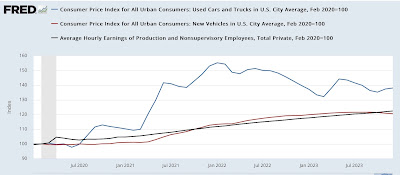A Discussion: EV Sales Have Been Stalling, While Hybrids Are Flying Off Dealer Lots
In addition to housing, the other big area where supply shock inflation has not completely resolved is vehicles. Basically almost the entirety of 2020 production was lost, leading to roughly a 10 million vehicle shortfall in the amount necessary to replace old vehicles. As the below graph shows, while new vehicles cost no more in “real” terms compared with average hourly supervisory wages, used vehicles continue to command a substantial premium:
Until both new and used vehicles normalize compared with wages, the supply crunch is not completely resolved.
While the latest data is three months old, and rates have probably come down somewhat since then (like all other interest rates), the interest rate on auto loans has gone up considerably since before the pandemic:
This is a good introduction to a discussion of why EV sales are waning somewhat, as indicated in the below graph (via Kevin Drum):
Here’s the snapshot. As of November,
“Car dealers across the country say they had a 114-day supply of new EVs … , compared to a 71-day supply of inventory for the auto industry overall. Historically, a 60 day supply across the auto industry was considered ideal.”
“New hybrids … are the quickest to sell, spending an average of 37.2 days on the lot.”
PBS had a very good discussion of why buyers have been turning more to hybrids than to EV’s. I recommend that you read it in its entirety, but here is a bullet point summary:
So far in 2023, Americans have bought a record 1 million-plus hybrids — up 76 percent from the same period last year, according to Edmunds.com….[plus] 148,000 plug-in hybrids, which drive a short distance on battery power before a gas-electric system kicks in.
Though electric vehicle sales are nearing an annual record of over 1 million this year, their year over year growth rate has begun to stall.
The reasons why hybrids have quickly become the preferred choice for many buyers vary. They range from the higher prices of comparable EVs to concern about the scarcity of charging stations to a recognition that hybrids provide many of the same advantages without the hassles of EVs.
Here are snapshots of the issues discussed in the article:
- Prices: “EV prices have being dropping, mainly a consequence of federal tax credits and price cuts by Tesla, the market leader. Yet they’re still pricier than hybrids or gas vehicles”
- Range issues: customers do not want to have to stop frequently for lengthy recharging of EV batteries, and worry that charging stations may not be available on long trips where they need them.
- Cold weather issues: “hybrid buyers appear to have done research and know that cold weather reduces the range of an EV battery. Tests conducted in Norway, … found that EVs lose between 10 percent and 36 percent of their range during winter.” The widely publicized debacle this past week in Chicago, where many EV’s were bricked because charging stations’ speed slowed to a crawl, and vehicles died while waiting in line, isn’t going to help.
- Reliability: “ Consumer Reports found that hybrids were the industry’s most reliable type of power system. Electric vehicles were least reliable.”
Two things the article did not mention: the necessity to pay for the installation of a 240 volt line in your garage to charge an EV, if you don’t want to rely on the public stations. And the fact that most hybrids now accelerate nearly as fast as, and sometimes even faster than, their internal combustion engine counterparts.
In the long run, if there is improvement in the range of EV batteries, the speed of recharging, and if prices decline to a level competitive to gas powered models, they will be an excellent improvement, both in terms of global climate and geopolitically ending the power of petrosheikhdoms.
In the meantime, as I noted in an earlier post, recently I had no choice but to get a new vehicle. Ultimately I chose a hybrid over an EV for almost all of the reasons discussed in the article above.
More By This Author:
Are Working Class Wages Really Still A Malady?Existing Home Sales Approach Bottom Near 30-Year Lows
Housing Construction Changes Little In December
Disclaimer: This blog contains opinions and observations. It is not professional advice in any way, shape or form and should not be construed that way. In other words, buyer beware.






